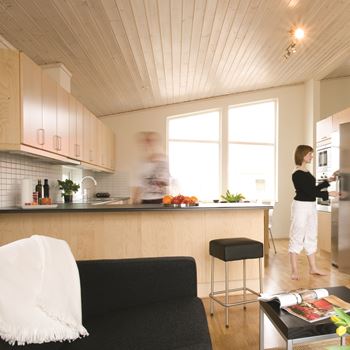The safety of the built environment is not only improved with good planning, but also with carefully done material choices. Building materials have a significant impact on things such as indoor air quality, moisture damage and fire safety, but also on the acoustic properties of the building, among others.
High quality indoor air promotes well-being and comfort

Good indoor air quality promotes the well-being and comfort of the tenants of a building while also improving efficiency. The quality of the indoor air can be significantly influenced by selecting low-emission interior materials. Today, there is a lot of research information on the safety and health effects of building materials. This research information is also the basis for many different types of regulations and classifications pertaining to building materials.
A good example of these are national classifications regarding VOC compounds (Volatile Organic Compounds), such as formaldehyde and ammonia. These classifications have been found to be effective practical tools when aiming to minimise harmful building emissions. The classifications help both the builder and the consumer select the building materials with minimal emissions in order to ensure the best possible indoor air quality.
Prevents lingering moisture
Building materials can be used to directly influence indoor air emissions, but they also have an important role in the moisture control of buildings. Moisture damage occurs when the structures have moisture that cannot evaporate sufficiently rapidly. Protecting building materials and structures from moisture along with high-quality technical construction prevent moisture from entering the structures and causing moisture damage. The best result is achieved when moisture control is exercised in every phase of the building’s life-cycle, also during use.
There are significant differences in the moisture tolerance of building materials, such as insulation materials. The more susceptible the material is to moisture damage, the greater the risk for microbial growth and compromised indoor air quality.
It is easier to utilise safe waste
Recycling materials is important also in construction, as the raw materials produced by the world are diminishing and we strive to reduce the climate impact from industrial activities. The goal set by the EU Waste Framework Directive is to utilise 70 per cent of the construction and demolition waste by 2020. Success in this requires the recycled materials to be safe, which makes recycling simpler and safer. Stone wool, for example, can be safely recycled as insulation, blown-in insulation, fill soil or soil structures.
Fire safety controls risks – and prepares for the worst
The fire safety of a building refers to controlling the risk of a fire occurring, the fire tolerance of load-bearing structures and ensuring the ability to escape, among others. From a construction material perspective, it must be ensured that fire-safe building products and technical equipment are used.
Insulation may increase the fire load of a building significantly, which is why the chosen insulation material has a large impact on the overall fire safety of a building. The safest solution in any building is to use an insulation material that is classified as non-flammable, such as glass or stone wool.
Noise under control using acoustic solutions
The sound environment in indoor environments affect people in many ways. Several studies have identified significant correlations between noise exposure and comfort, well-being and even harmful health effects. Noise exposure has traditionally been linked with factories, workshops and traffic, but noise is increasingly a focus also in other environments, such as schools, nurseries and offices.
No need to worry! Noise levels can be reduced in nearly all environments by utilising acoustic products that dampen sounds, such as acoustic boards hung from or installed on the ceiling or walls.
As made evident, construction materials can be used to affect many of the safety factors of the built environment. Therefore, openly sharing information as actively as possible on the properties and behaviour of building materials in different conditions is important and improves the ability to make safer choices already during planning. This is to the benefit of us all.

Jari Airola
Managing Director, Building Insulation, PAROC